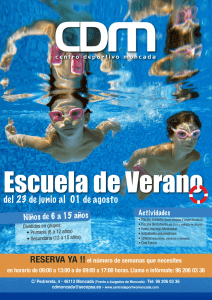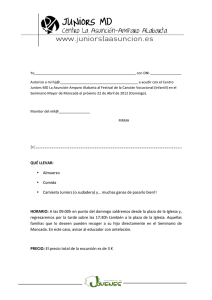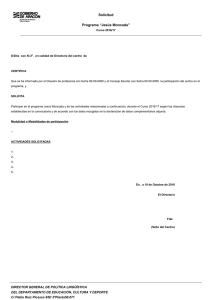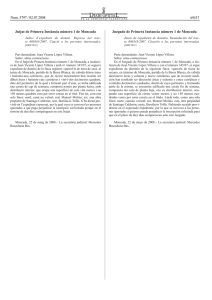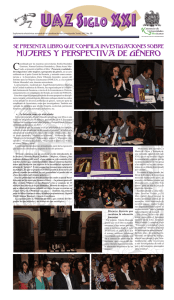THREE ENGRAVERS AT THE SERVICE OF A SICILIAN CARDINAL
Anuncio
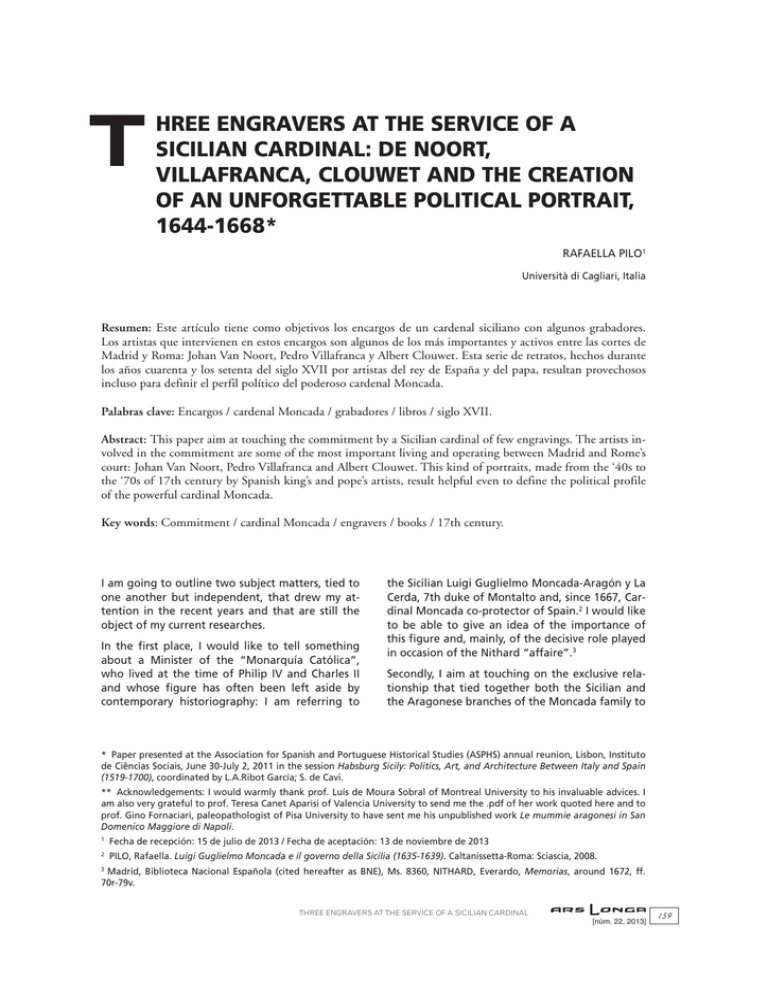
T HREE ENGRAVERS AT THE SERVICE OF A SICILIAN CARDINAL: DE NOORT, VILLAFRANCA, CLOUWET AND THE CREATION OF AN UNFORGETTABLE POLITICAL PORTRAIT, 1644-1668* RAFAELLA PILO1 Università di Cagliari, Italia Resumen: Este artículo tiene como objetivos los encargos de un cardenal siciliano con algunos grabadores. Los artistas que intervienen en estos encargos son algunos de los más importantes y activos entre las cortes de Madrid y Roma: Johan Van Noort, Pedro Villafranca y Albert Clouwet. Esta serie de retratos, hechos durante los años cuarenta y los setenta del siglo XVII por artistas del rey de España y del papa, resultan provechosos incluso para definir el perfil político del poderoso cardenal Moncada. Palabras clave: Encargos / cardenal Moncada / grabadores / libros / siglo XVII. Abstract: This paper aim at touching the commitment by a Sicilian cardinal of few engravings. The artists involved in the commitment are some of the most important living and operating between Madrid and Rome’s court: Johan Van Noort, Pedro Villafranca and Albert Clouwet. This kind of portraits, made from the ‘40s to the ‘70s of 17th century by Spanish king’s and pope’s artists, result helpful even to define the political profile of the powerful cardinal Moncada. Key words: Commitment / cardinal Moncada / engravers / books / 17th century. I am going to outline two subject matters, tied to one another but independent, that drew my attention in the recent years and that are still the object of my current researches. In the first place, I would like to tell something about a Minister of the “Monarquía Católica”, who lived at the time of Philip IV and Charles II and whose figure has often been left aside by contemporary historiography: I am referring to the Sicilian Luigi Guglielmo Moncada-Aragón y La Cerda, 7th duke of Montalto and, since 1667, Cardinal Moncada co-protector of Spain.2 I would like to be able to give an idea of the importance of this figure and, mainly, of the decisive role played in occasion of the Nithard “affaire”.3 Secondly, I aim at touching on the exclusive relationship that tied together both the Sicilian and the Aragonese branches of the Moncada family to * Paper presented at the Association for Spanish and Portuguese Historical Studies (ASPHS) annual reunion, Lisbon, Instituto de Ciências Sociais, June 30-July 2, 2011 in the session Habsburg Sicily: Politics, Art, and Architecture Between Italy and Spain (1519-1700), coordinated by L.A.Ribot García; S. de Cavi. ** Acknowledgements: I would warmly thank prof. Luís de Moura Sobral of Montreal University to his invaluable advices. I am also very grateful to prof. Teresa Canet Aparisi of Valencia University to send me the .pdf of her work quoted here and to prof. Gino Fornaciari, paleopathologist of Pisa University to have sent me his unpublished work Le mummie aragonesi in San Domenico Maggiore di Napoli. 1 Fecha de recepción: 15 de julio de 2013 / Fecha de aceptación: 13 de noviembre de 2013 2 PILO, Rafaella. Luigi Guglielmo Moncada e il governo della Sicilia (1635-1639). Caltanissetta-Roma: Sciascia, 2008. Madrid, Biblioteca Nacional Española (cited hereafter as BNE), Ms. 8360, NITHARD, Everardo, Memorias, around 1672, ff. 70r-79v. 3 THREE ENGRAVERS AT THE SERVICE OF A SICILIAN CARDINAL [núm. 22, 2013] 159 the one of the Dukes of Alcalá –the Andalusian Enríquez de Ribera–,4 and to the one of the Marquises of Castel Rodrigo –the Moura family, who were Portuguese and faithful to the catholic crown.5 Apart from the obvious attention due to the matrimonial and patrimonial logic, it seems to me particularly interesting the identification of the strongholds of a shared cultural-political practice that tied the three families together and, in particular, the expression of the common «modus operandi» adopted by those, among them, who held relevant institutional offices during the Baroque age.6 The freshness and the originality of this approach is the aim of focusing on the identities of an almost unknown minister (as in Luigi Moncada case, who was a forgotten protagonist during the second half of the 17th century as I had tried to demonstrate in my recent works) and his relationship with aristocrats (as his father in law duque of Alcalá and, especially as his uncle by marriage marquis of Castel Rodrigo) whose artistic taste and commissioning is widely known. Let’s proceed in the right order: Luigi Guglielmo Moncada’s biographic portrait I will present here will be necessarily a very concise one.7 He was born in Palermo in 1614 by a Sicilian father, Antonio Moncada, and a Spanish mother; she was Juana de La Cerda, daughter of the Duke of Medinaceli, and niece of the Duke of Alburquerque. Therefore, she came from the highest Castilian aristocracy.8 Luigi Guglielmo spent his childhood with his brothers in Sicily, where the Moncada were among the main Feudatories of the Kingdom. In 1626, when his older brother Francesco died and his parents interrupted their marriage by the agreement of Pope Urban VIII9 and, as both had chosen the ecclesiastical life, decided to spend it in Naples, he became universal heir of all the feuds Moncada family owned in Sicily.10 4 GONZÁLEZ MORENO, Joaquín. Don Fernando Enríquez de Ribera, tercer duque de Alcalá de los Gazules (1583-1637). Sevilla: Ayuntamiento de Sevilla,1969. 5 About Portuguese aristocracy’s attitude see VALLADARES, Rafael. Portugal y la monarquía hispánica, 1580-1668. Madrid: Arco libros, 2000; BOUZA ALVAREZ, Fernando. “A nobreza portuguesa e a corte de Madrid. Nobres e luta política no Portugal de Olivares”. In: Portugal no tempo dos Filipes. Pólitica, cultura, representações (1580-1668). Lisboa: Cosmos, 2000, pp. 207256; CARDIM, Pedro. “Los portugueses frente a la Monarquia Hispanica”. In: ALVAREZ-OSSORIO ALVARIÑO, A.; GARCIA GARCIA, B. (eds.). La Monarquía de las Naciones. Patria, nación y naturaleza en la Monarquía de España. Madrid, 2004, pp. 355383. About Moura family political action between the end of the XVIth century and the first half of the XVIIth, see also BOUZA ALVAREZ, Fernando. Corre manuscrito. Una historia cultural del siglo del Oro. Madrid: Marcial Pons Historia, 2001; MARTÍNEZ HERNÁNDEZ, Santiago. “Os marqueses de Castelo Rodrigo e a nobreza Portuguesa na Monarquia hispânica: estratégia de legitimação, redes familiares e intereses políticos entre a agregação e a restauração (1581-1651)”. In: Ler Historia, 2009, n. 57, p. 7-32. About Manuel de Moura see also ELLIOTT, John H. El Conde Duque de Olivares. El político en una época de decadencia. Barcelona: Crítica, 1990, p. 59 et seq.; about his patronage of the arts in Rome during the years of his embassy, see the classic studies by CONNORS, Joseph. Borromini e l’Oratorio romano, Torino, 1989; CONNORS, Joseph. “Borromini and the Marquese di Castel Rodrigo”. In: The Burlington Magazine, July 1990, vol. 133, num. 1060, pp. 434-440; BROWN, Jonathan; ELLIOTT, John H. A Palace for a King. The «Buen Retiro» and the Court of Philipe IV. In: New Haven-London, 1980, Yale University Press; VARELA GOMES, Paulo. Arquitectura, religião e política em Portugal no século XVII: a planta centralizada, Porto: Faculdade de Arquitectura, 2001; VARELA GOMES, Paulo. “Obra crespa e relevante, os interiores das igrejas lisboetas na segunda metade do século. XVII – alguns problemas”. In: MOURA SOBRAL, Luís de (ed). Bento Coelho (1620-1708) e a Cultura do seu Tempo. Lisboa: Instituto Portugués do Patrimonio Arquitectónico, 1998, pp. 107-125; MOURA SOBRAL, Luís de., “Damnatio memoriae. A arquitectura dos marqueses de Castelo Rodrigo”. In: COLOMER, J. L. (ed.), Arte y diplomacia de la monarquía hispánica en el siglo XVII. Madrid: Ed. Fernando Villaverde, 2003, pp. 351-376. 6 KOENINGSBERGER, Helmut G. L’esercizio dell’impero. Palermo: Sellerio, 1997 (or. ed. 1969). PILO, Rafaella. “Memoriales y cartas de un cardenal que quisiera ser valido. Un brillante ejemplo de construcción de la memoria”. In: JANÉ, Ó.; MIRALLES, E.; FERNÁNDEZ, I. (eds.). Memòria personal. Una altra manera de llegir la història. Barcelona: Universitat Autònoma de Barcelona, Bellaterra, 2013, pp. 99-109. 7 8 Antonio Moncada married in Madrid Juana de La Cerda y La Cueva, daughter of the del VI duca di Medinaceli Juan de La Cerda (brother-in-law of Philip III’s valido duke of Lerma) and niece of Francisco Fernández de La Cueva, VII duke of Alburquerque. About the «pax hispánica» period see ALLEN, Paul C. Philip 3 and the Pax Hispánica, 1598-1621: the failure of grand strategy. New Haven-London: Yale University Press, 2000; GARCÍA GARCÍA, Bernando J. La Pax hispánica. Política exterior del duque de Lerma. Leuven: Leuven University Press, 1996. About the ways of integration between princes and italian feudatories in Spanish circle, see SPAGNOLETTI, Angelantonio. Principi italiani e Spagna nell’età barocca. Milano: Mondadori, 1996, pp. XI-XVIII; for the Sicilian case, see BENIGNO, Francesco. “Aristocrazia e stato in Sicilia nell’epoca di Filippo III”. In VISCEGLIA, M. A. (ed.). Signori, patrizi, cavalieri nell’età moderna. Roma-Bari: Laterza, 1992, pp. 76-93, but especially p. 80 et seq. 9 Toledo, Archivo Histórico Nacional, Sección Nobleza, Moncada, cp. 92, n. 387: “Paper of annulment signed by Urban VIII in Rome”, on February the 10th, 1626. 10 Palermo, Archivio di Stato, Protonotaro del Regno, Processi d’Investitura, b. 1575, fasc. 4413: «Processus de Investitione Ducatus Bisbone et Aliorum pro Illustre Don Aloisio de Aragona Moncada et La Cerda», June, 1627; fasc. 4440, «Processus de Investitione Comitatus Collesani et Aliorum pro Illustre Don Aloisio de Aragona Moncada et La Cerda», June, 1627. 160 RAFAELLA PILO [núm. 22, 2013] Fig. 1. Luigi Guglielmo Moncada at the Age of the Viceroyalty in Sicily (c.ca 1635-1639), in G.E. di Blasi, Storia cronologica dei viceré, luogotenenti e presidenti del Regno di Sicilia, Pietro Pensante, Palermo, 1867, s.p., ill. V e VI. Burin. Anonymous artist. In 1629 he married in Naples the daughter of the viceroy Fernando Afán Enríquez de Ribera, Duke of Alcalá, and, from 1629 to 1635, he lived between Naples and Rome: respectively at the court of his father-in-law, the viceroy, and at the one of the Spanish ambassador to the Holy See, Manuel de Moura y Corte Real, Marquis of Castel Rodrigo, an uncle by marriage.11 The influence these two figures had on him goes well beyond the familiar bounds and it proves to be fundamental for the political upbringing of the young Moncada and, most of all, for the development of an autonomous cultural and artistic sensibility.12 The Viceroy Alcalá and the Ambassador Castel Rodrigo were both considered fine collectors and patrons of the arts by their contemporaries: the Duke of Alcalá owned a collection of books that was envied even by the Count-Duke of Olivares, who was a remarkable collector himself; moreover, Alcalá was also a good friend of Francisco Pacheco (Diego Velázquez’s father-in-law and master) and of Jusepe Ribera, “the Little Spaniard”, who was in Naples during the years of his government just like Velázquez.13 Regarding the Marquis of Castel Rodrigo, for instance, we could mention the commissions entrusted to Francesco Borromini, who was still not very well-known, to the Flemish sculptor François Duquesnoy, to Nicolas Poussin and to Claude Lorrain, that is some of the most famous artists of the Roman Baroque.14 11 About the fellowship among Moncada, his father-in-law and the ambassador Castel Rodrigo, its stability is quite evidently during the affaire Camutio in which Moncada had been involved in Velletri in 1635: see it in DANDELET Thomas. J. La Roma española (1500-1700). Barcelona: Crítica, 2002, p. 237 et seq. See also, for a pretty different version, PILO, Rafaella, 2008, (note 2) pp. 39-46. 12 The relationship among the three men, started and grew up during the decade 1629-1639 between Naples and Rome, is the object of a current research which first steps had been OLIVÁN, Laura; PILO, Rafaella. “Recetario en busca de dueño: perfumería, medicina,y confitería en la casa del VII duque de Montalto (1635-1666)”, Cuadernos de Historia Moderna, 2012, vol. 37, pp. 103-125, and, also, PILO, Rafaella. “Da Palermo a Napoli e nelle Fiandre: Anna Maria Moncada-Aragón y la Cerda, marchesa di Castel Rodrigo”. In: MAFRICI, M. coord. Alla Corte napoletana. Donne e potere dall’età aragonese al viceregno austriaco (1442-1734). Napoli: Fridericiana Editrice Universitaria, 2012, pp. 179-188. For a distinguished biography of the duke of Alcalá, see GONZÁLEZ MORENO, Joaquín, 1969 (note 4). About the relationship between Ribera and the Viceroys of Naples see, now, FINALDI, Gabriele. “Ribera, the Viceroys of Naples and the King. Some Observations on their Relations”. In COLOMER, José Luis, 2003, (note 5), pp. 379-388. 13 A particular attention has been lately given to the Marquis of Castel Rodrigo also by some young researchers: GARCÍA CUETO, David. “Mecenazgo y representación del marqués de Castel Rodrigo durante su embajada en Roma”. In: HERNANDO SÁNCHEZ, C. J. coord. Roma y España. Un crisol de la cultura europea en la edad moderna. Madrid: Sociedad Estatal para la Acción Cultural Exterior, 2007, vol. II, pp. 695-716; MARTÍNEZ HERNÁNDEZ, Santiago, 2009 (note 5), pp. 7-32; SOMMER MATHIS, Andrea, “‘Admirables efectos de la providencia..’. Fiesta y poder con motivo de coronaciones en el Sacro Imperio Romano”, Studia Historica. Historia Moderna, 2009, 31, pp. 53-94. About the relationship with François Duquesnoy, see LINGO, Estelle. François Duquesnoy 14 THREE ENGRAVERS AT THE SERVICE OF A SICILIAN CARDINAL [núm. 22, 2013] 161 But let’s return to Moncada: he developed a distinct skill in combining the political-institutional aspects with the artistic choices and, in the period during which he held some administrative offices as viceroy –in Sicily, in Sardinia and in Valencia–, he put in practice the precious combination.15 It is during the second half of the 30s in Sicily that he had the chance of expressing his own artistic taste: in the island, he commissioned several works of art and he was the promoter of the construction of several monuments. Among them, there are some examples of baroque architecture in Palermo (the coats of arms of the Moncada Family at the “Casa Professa”, a Montalto Gate now reduced to a ruin) and in Caltanissetta –a main feud of the Moncadas and the seat, in the previous century, of a sumptuous peripheral court–16 where he commissioned the construction of a magnificent palace he was never to visit.17 As he arrived in Madrid in 1659, Moncada obtained the title of “gentilhombre de Cámara” of the king Philip IV with the support of the new “valido” Luis de Haro and, soon after, he was given the highly sought-after charge of “mayordomo mayor” of Marianna of Austria, second wife of Philip IV and mother of the heir to the throne.18 Although the relationship with the queen was doomed to wear off in a few years’ time, in 1666 he was named member of the “Consejo de Estado”.19 Apparently, this was a highly prestigious charge but, in reality, it was only an honorary title since the power was now held by a new body: the “Junta de Gobierno”.20 But, even excluded from the «Junta de Govierno», Moncada consoled himself, in 1667, receiving a Cardinal’s hat from Pope Alexander VII Chigi. According to his enemies –and there were many in Madrid– such an appointment had been determined by the intention of moving the new Cardinal away from the Spanish court to Rome as soon as possible.21 In reality, he left Spain only in 1674 when his deadly remains were transferred to the Church of San Domenico Maggiore in Naples, where they still are today.22 At this point, I would like to take a small step back since it was during the years of his maturity that the Cardinal played a relevant role in the court of Madrid. In fact, he was one of the fiercest opponents of the “privado” of the queen, the Jesuit Nithard, and one of the conspirators that caused his expul- and the Greek Ideal. New Haven-London: Yale University Press, 2007; with Poussin, see BENNASSAR, Bartolomé. La España del siglo de Oro. Barcelona: Crítica, 2003 (or. ed. 1982), p. 259; with Lorrain, see RUSSELL, Helen D. Claude Lorrain (1600-1682). New York: National Gallery of Art, 1982, p. 75. See, in general, BROWN Jonathan; ELLIOTT John H., 1980, (note 5). 15 SCALISI, L. (coord.). La Sicilia dei Moncada. Le corti, l’arte e la cultura nei secoli XVI-XVII. Catania, 2006. GIARRIZZO, Giuseppe. “Alla corte dei Moncada (secoli XVI-XVII)”, Annali di Storia Moderna e Contemporanea, 1999, 5, pp. 429-436. 16 17 VULLO, Daniela. “Palazzo Moncada a Caltanissetta. La storia di un principe attraverso i “registri di fabbrica” e i “conti di taglio”. In: SCALISI, Lina, 2006 (note 15), pp. 287-299. 18 About the figure of the queen mother, see OLIVÁN SANTALIESTRA, Laura. Mariana de Austria: imagen, poder y diplomacia de una reina cortesana. Madrid: Universidad Complutense, 2006. About the problematic age of Charles II of Spain, see the classical studies by MAURA GAMAZO, Gabriel. Carlos II y su corte, 2 Vols. Madrid: 1911-1915; MAURA GAMAZO, Gabriel., Vida y reinado de Carlos II, 3 vols. Madrid: 1942. See also KAMEN, Henry. La España de Carlos II. Barcelona: Crítica, 1981; RIBOT GARCÍA, Luis Antonio. “La España de Carlos II”. In: MENÉNDEZ PIDAL, Historia de España: La transición del siglo XVII al XVIII entre la decadencia y la reconstucción, t. XXVIII. Madrid: Espasa-Calpe, 1997; RIBOT GARCÍA, Luis Antonio. “Carlos II: el centenario olvidado”, Studia historica. Historia moderna, 1999, nº 20, pp. 19-44; RIBOT GARCÍA, Luis Antonio. “Biografías imprescindibles. nº 13: Carlos II. El monarca incapaz”, Clío, 2007, nº. 63, pp. 76-89. 19 Madrid, Archivo Histórico Nacional, Estado, Servicios Exteriores, leg. 248/13, Madrid on January 15th, 1666: Her Mayesty, the Queen: “Haciendo merced del puesto de Consejeros de Estado a los señores Duque de Alburquerque, cardenal Colona, Duque de Montalto, Don Luís Ponce, Conde de Ayala, Juan Everardo Nithardo de la Compañía de Jesus confesor de la Reyna Nuestra Señora y al marqués de La Fuente”. See, in general, BARRIOS, Feliciano. El Consejo de Estado de la monarquía española 1521-1812. Madrid: Consejo de Estado, 1984. 20 Los secretarios de Estado y del despacho (1474-1724), IV vols., J.A. Escudero López ed., Madrid, Instituto de. Estudios Administrativos, 1976. About the important role played by the Junta also in the contrast with the Consejo de Estado, see SEVILLA GONZÁLEZ, Mari C. “La Junta de Gobierno en la minoridad del Rey Carlos II”. In: ESCUDERO LÓPEZ, J. A. (ed.). Los validos. Madrid: Dykinson, 2004, pp. 583-616. 21 About the ambiguous feelings towards cardinal Moncada at Madrid’s court, see MAURA GAMAZO, Gabriel, 1911-15 (note18), vol. I, p. 138 et seq. 22 FORNACIARI, Gino. “Food and disease at the Renaissance courts of Naples and Florence: A paleonutritional study”. In: Appetite, 2008, 51, pp. 10-14; FORNACIARI, Gino., “Italian mummies”. In: Mummies, disease and ancient cultures, A. Cockburn et al. Cambridge: Cambridge University Press, 1998, pp. 266- 281. 162 RAFAELLA PILO [núm. 22, 2013] sion from the court of Madrid in 1669.23 Among the conspirators, whose names are reported by Nithard himself in his memoirs, that are held at the «Biblioteca Nacional de España» in Madrid, one can find distinguished personalities such as the Cardinal Pascual Aragón, the Count of Peñaranda, the Duke of Medina de las Torres, and the papal nuncio, Cardinal Federico Borromeo; but it was to Cardinal Moncada that he reserved some of the harshest words: One of worst persecutors was the duke of Montalto, now cardinal Moncada, who –as from good wine you could obtain good vinegar– used to be my best friend (as he played and said) and suddenly became my worst and most cruel enemy.24 As an introduction to the second half of the paper, regarding the importance of the politicalartistic bond of the Moncada-Enríquez de RiberaMoura clan, it could be useful recalling that in 1658 Luigi Guglielmo was left a widower for the second time: in fact, in 1643 he had married in Madrid Caterina Moncada de Castro, daughter of the third Marquis of Aytona, renowned writer and soldier.25 At the time of the wedding, his daughter Caterina was a lady-in-waiting of the queen Elisabeth of Bourbon, first wife of Philip IV26: partly influenced by the environment of the court, where she had been brought up together with her brothers, and partly by her father’s artistic tastes and choices, she contributed, no less than the above-mentioned Duke of Alcalá and Marquis of Castel Rodrigo, in determining the choices of her husband’s Fig. 2. BRAH, Colección Salazar y Castro, B30: Title-page of J. Pellicer de Tovar, Iustificación del tratamiento igual con los vireyes de Nápoles y Sicilia que pretende el principe duque de Montalto y Bivona, inéd., Madrid, 1644. Burin. Signed by Juan de Noort. cultural policy.27 It is no accident but, rather, the fruit of a very wise policy that, one year after the wedding, Caterina and Luigi succeeded commissioning from an influential and well known writer as Joseph Pellicer de Tovar the work Iustificación del tratamiento de igual con los vireyes de 23 PILO, Rafaella. “Casi todos los hombres del cardenal Moncada. La conjura de otoño (octubre de 1668-marzo de 1669)”. In: DE BERNARDO ARES, José Manuel (coord.). Sucesión de la Monarquía Hispánica. Córdoba: Universidad de Córdoba, 2006, pp. 257-275. 24 “Entre los demás mis persecutores fue uno de los más señalados el duque de Montalto, ahora cardenal de Moncada, que como del buen vino se hace buen vinagre, así él, de más fino amigo, (según se mostraba y profesaba), se volvió a ser my mayor, y más cruel enemigo”, from Nithard’s Memorias already quoted and now partially edited in PILO, Rafaella. Juan Everardo Nithard y sus “Causas no causas”. Razones y pretextos para el fin de un valimiento. Madrid: Sílex, 2010. 25 See GUTIERREZ, Jesús. “Don Francisco de Moncada, el hombre y el embajador. Selección de textos inéditos”. Boletín de la Biblioteca Menéndez Pelayo, 1980, LVI, pp. 3-72; MOLAS RIBALTA, Pere. L’alta noblesa catalana a Edat Moderna. Vic: Eumo, 2003, p. 59-61. About his daughter Caterina Moncada de Castro see DELLA LENGUEGLIA, Giovanni A. Ritratti della Prosapia et heroi Moncadi nella Sicilia. Opera Historica-Encomiastica, 2 Vols., Valencia: Vincenzo Sacco, 1657, vol. II, pp. 472-478. See, now, PILO, Rafaella. “Juegos de Cortes en la época barroca: éxitos y derrotas de los duques de Montalto”. In: MARTÍNEZ MILLÁN, J.; MARÇAL LOURENÇO, M. P. (coords.). Las relaciones discretas entre las monarquías hispana y portuguesa: Las casas de las reinas (siglos XV-XIX), Madrid: Polifemo, 2008, vol. II, pp. 1429-1442. 26 PIZARRO LORENTE, Henar, “Isabel de Borbón: de princesa de Francia a reina de España (1615-1623)”, in MARTÍNEZ MILLÁN, J.; MARÇAL LOURENÇO, M. P., 2008 (note 25), vol. I, p. 339-394; LOSA SERRANO, Pedro; CÓZAR GUTIÉRREZ, Ramón. “Confidencias de una reina. Isabel de Borbón y la condesa de Paredes”. In: LÓPEZ CORDÓN, M. V. et al. La reina Isabel y las reinas de España: realidad, modelos e imagen historiográfica. Madrid: Fundación Española de Historia Moderna, 2005, vol. I, pp. 523-536; NEGREDO DEL CERRO, Fernando “La gloria de sus reinos, el consuelo de sus desdichas. La imagen de Isabel de Borbón en la España de Felipe IV”. In: LÓPEZ CORDÓN, M. V. et al. pp. 465-484. See, now, OLIVÁN SANTALIESTRA, Laura, “Isabel de Bourbon”. In: PÉREZ CANTÓ, Isabel et al. Rainhas de Portugal e Espanha, vol. 11. Lisboa, 2011. 27 DELLA LENGUEGLIA, Giovanni A., 1657 (note 25), vol. II, pp. 472-473. THREE ENGRAVERS AT THE SERVICE OF A SICILIAN CARDINAL [núm. 22, 2013] 163 and, in particular, of the Marquis of Aytona who had recently passed away. The six sovereigns portrayed, explicitly identified as the ones of Aragon, Bavaria, Navarre, Naples, France and Sicily, all dressed with military clothes, are placed under an architectonic structure of classic inspiration and they all look alike both in their features and their bearing. The figures portrayed catch, quite evidently, the physiognomy of the young Luigi Guglielmo Moncada and, as a matter of fact, they are not too different from the medals portraying him at the times of the rule of Sicily.30 Fig. 3. Luigi Guglielmo Moncada is been given a gift by the Valencian jurist Lorenzo Mateu i Sanz, in J. de Solórzano Pereira, Los emblemas regio-políticos, Bernardo Noguès, Valenza, 1658. Burin. Anonymous artist. Nápoles y Sicilia que pretende el principe duque de Montalto y Bivona.28 The frontispiece of the work is a nice engraving by the Flemish master Johan Van Noort, who was a valued artist of Philip IV’s court:29 the title of the work appears in capital letters at the centre of a loggia that is framing the whole page in a space prearranged «ad hoc». The loggia is over-towered by several war symbols –cannons, ammunition, spears, helmets, shields– emblems of the military value of the ancestors of the Duke of Montalto During the entire Seventeenth century used to work in Madrid some foreigners engravers, such as Schorquens, de Noort and Madame de Beer, who refined the technique of “buril” and whose job kept in very stretch relationship with the field of publishing and with the parallel diffusion of imagines as a system of communication. In this work de Noort succeed, with a brilliant ability, to synthesize in a page space a myriad of symbols that refer, in part, to the pages of the book and, by the other part, to the very same ratio of the commitment.31 Another example of a frontispiece where it appears the image of Moncada, whose author is unfortunately unknown, dates to the years of the Viceroyalty in Valencia: it is the frontispiece of a translation from Latin to Castilian of the work Emblema regio-políticos written by the jurist Juan Solórzano Pereira that had been commissioned by Moncada to a young jurist from Valencia, Lorenzo Mateu i Sanz, who would later become vice-Chancellor of the “Consejo de Aragón”.32 28 Madrid, Biblioteca de la Real Academia de la Historia (cited hereafter as BRAH), Colección Salazar y Castro, B30: it could be useful stating beforehand that the text I found at the during a two-month period February-March 2004 is composed by a first half in print and a second half (about 100 pages long) handwritten. 29 GARCÍA GARCÍA, Bernardo J. “Arquitecturas y efectos de la fiesta”. In: V.V.A.A. Teatro y fiesta del Siglo de Oro en tierras europeas de los Austrias. Madrid: Abada Editores, 2003, p. 138-156; CUESTA GARCÍA DE LEONARDO, Maria J.; ORANTES LOBÓN, Luis. “El Árbol de la Sabiduría a través de una estampa desconocida de Juan de Noort”, Cuadernos de arte de la Universidad de Granada, 1985-86, nº 17, pp. 47-66; SANTIAGO PÁEZ, Elena “La azarosa historia de dos libros ilustrados por Juan de Noort”. In: CELESTINO ANGULO, Sonsoles (coord.). De libros y bibliotecas: homenaje a Rocío Caracuel. Sevilla: Universidad de Sevilla, 1995, pp. 373-388. 30 Two medals retraiting Luigi Guglielmo Moncada at the age of his vicereign in Sicily in DI BLASI, Giovanni E. Storia cronologica dei vicerè luogotenenti e presidenti del Regno di Sicilia. Palermo: Pietro Pensante, 1867, ill. V-VI. 31 GARCÍA VEGA, Blanca. El grabado del libro español. Siglos XV-XVI-XVII. Valladolid: Institución Cultural Simancas, 1984, vol. II, p. 328. See, now, SANTIAGO PAEZ, Elena. “Grabadores flamencos en el Madrid de Felipe IV: Alardo de Popma, Juan de Noort y Herman Panneels”. In: PITA ANDRADE, José Manuel; RODRÍGUEZ REBOLLO, Ángel (coords.). Tras el Centenario de Felipe IV. Jornadas de Iconografía y Coleccionismo dedicadas al profesor A. E. Pérez Sánchez. Madrid: FUE, 2006, pp. 183-206; BLAS, Javier; DE CARLOS VARONA, María Cruz; MATILLA, José Manuel (coords.). Grabadores extranjeros en la Corte española del Barroco. Madrid: Centro de Estudios Europa Hispánica, 2011. 32 DE SOLÓRZANO PEREIRA, Juan. Los emblemas regio-políticos. Valencia: Bernardo Noguès, 1658. See infra p. 8. About the members of the Consejo de Aragón see ARRIETA ALBERDI, Jon. El Consejo Supremo de la Corona de Aragón (1494-1707). Zaragoza: Institución “Fernando el Católico”, 1994; ARRIETA ALBERDI, Jon., “El papel de los juristas y magistrados de la Corona de Aragón en la conservación de la Monarquía”, Estudis, 2008, 34, pp. 9-59. About the valencian jurist see CANET APARISI, Teresa. “Matrimonio, fortuna y proyección social en la élite administrativa valenciana del siglo XVII. Los casos de Sanz y 164 RAFAELLA PILO [núm. 22, 2013] The image portrays the translator while giving a basket of food to the one who had commissioned the work: we may notice that the Sicilian aristocrat was not very tall considering that, even in an undoubtedly commemorative context as this one, he is, curiously enough, immortalized as smaller than the one who is paying homage to him, with the motto “acceptum reddendo” (giving back for something received). Moreover: a work of the utmost importance for the reconstruction of the genealogical and political events regarding the Sicilian and Aragones branches of the Moncada family dates back to the same years: it is I Ritratti della Prosapia et heroi Moncadi printed in Valencia in 1657. The author is Giovanni Agostino Lengueglia, a Somascan father charged with the education of Luigi’s and Caterina’s son: Fernando Aragón-Moncada y Moncada, 8th Duke of Montalto, a figure that would have played a crucial role at the moment of the dynastic passage from the rule of Charles II of Habsburg to Philip V of Bourbon.33 The work, whose aim was clearly encomiastic, is embellished by the intervention of another of the most famous and appreciated artists of Philip IV’s court: Pedro Villafranca y Malagón34. The engraver portrayed several Moncada’s ancestors, such as the Duchess Caterina and the author of the work himself, but in the two volumes composing the work, there are no engravings portraying Luigi Guglielmo. a work by Alonso de San Gerónimo dedicated to him and published in Madrid in 1668.35 However, Villafranca succeeded immortalizing him a few years later in an engraving included in At the British Library,36 at the “Biblioteca Apostolica Vaticana”37 and at the “Biblioteca Nacional Fig. 4. Cardinal Luigi Guglielmo Moncada, in A. de San Gerónimo, Vida, virtudes y milagros de la prodigiosa virgen y madre Ana de San Agustín, Francisco Nieto, Madrid, 1668. Burin. Signed by Pedro Villafranca y Malagón. Matheu”. In: FRANCH BENAVENT, Ricardo; BENÍTEZ SÁNCHEZ-BLANCO, Rafael (eds.), Estudios de Historia Moderna en Homenaje a la profesora Emilia Salvador Esteban. Valencia: Universitat de València, 2008, pp. 73-99. About the wholehearted loyalty to the crown by Crespí and Mateu i Sanz see ARRIETA ALBERDI, Jon. “Ubicación de los reinos de la Corona de Aragón en la Monarquía y formas de vinculación: concepciones y supuestos varios”. In: BIROCCHI, I.; MATTONE, A. (eds.) Il diritto patrio. Tra diritto comune e codificazione (secoli XVI-XIX). Roma: Viella, 2006, pp. 127-171. 33 PILO GALLISAI, Rafaella. “Aragón-Moncada y Moncada Fernando de”. In: Diccionario Biográfico Español, Vol. IV. Madrid: Real Academia de la Historia, 2010, pp. 681-683. 34 GALLEGO, Antonio. Historia del Grabado en España. Madrid: Cátedra, 1979; BARRIO MOYA, José L. “Pedro de Villafranca y Malagón, pintor y grabador manchego del siglo XVII”, Cuadernos de Estudios Manchegos (cited hereafter as CEM), 1982, 13, pp. 107-122; BARRIO MOYA, José L. “Nuevas noticias sobre la actividad artística de Pedro de Villafranca y Malagón”. CEM, 1988, 18, p. 343-351. See, now, McDONALD, Mark. “Pedro Perret and Pedro de Villafranca y Malagón, Printmakers to the Spanish Hapsburgs”. Melbourne Art Journal, 2000, 4, pp. 37-51; MATILLA, José Manuel. “Aprender a dibujar sin maestro. Las cartillas de dibujo en la España del siglo XVII: el caso de Pedro de Villafranca”. In: RIELLO, José (dir.). Sacar de la sombra lumbre. La teoría de la pintura en el Siglo de Oro (1560-1724). Madrid: Museo Nacional del Prado-Abada Editores, 2012. 35 DE SAN GERÓNIMO, Alonso. Vida, virtudes y milagros de la prodigiosa virgen y madre Ana de San Agustín. Madrid: Francisco Nieto, 1668. See infra p. 10. 36 London, British Library (cited hereafter as BL), Add. 8703, f. 89r: imagine of cardinal Moncada engraved by Albert Clouwet, in single leaf. 37 Città del Vaticano, Biblioteca Apostolica Vaticana (cited hereafter as BAV), sez. GDS, fondo Stampe, Cardinali f 6 (1) f. 104: Cardinalium s.r.e. Imagines, Ex calcografia Rev. Camerae Apostolicae, 4 vol., vol. I, f. 104: “Ludovicus S.R.E Diaconus Cardinalis Moncada et de Aragonia Hispanus, die VII Martii MDCLXVII, die 7 Martii 1667; Objit. Die 5 maij 1672”. THREE ENGRAVERS AT THE SERVICE OF A SICILIAN CARDINAL [núm. 22, 2013] 165 de España”38 I run into an engraving by Albert Clouwet, a Flemish artist living in Italy, portraying the Cardinal Moncada. Curiously enough, the subject portrayed by Clouwet hardly resembles the one portrayed by Villafranca in the same months. So: Moncada never left Madrid since 1658 and Clouwet worked mainly in Italy, usually in Rome at the Pope’s court. Therefore: the Flemish artist is highly unlikely to have met Moncada and he had recreated a face of the cardinal, possibly getting the inspiration from the portraits of well-known personalities –who knows, maybe some other cardinal– or he had tried, some way, to fit the face of the cardinal in an “unforgettable” ideal-type. Fig. 5. Cardinal Moncada in BNE, ER 151, Illustración de Effigies, nomina et cognomina S.D.N.Alexandri Papae VII, Albert Clouwet, Roma, 1672 c.ca, “Ludovicus S.R.E. Diaconus Cardinalis Moncada et Aragonia Hispanus, die VII Martii MDCLXVII. Obijt die 3 maij 1672”. Burin. Signed by Albert Clouvet. In conclusion, it would be interesting reflecting on the relationship between the artistic commissioning and the mystification of reality or, in this case, on the missing mystification adopted by Villafranca and by the anonymous author of the engraving published in Valencia and on their hidden reasons with an exhaustive study of the path and the means that made possible the involvement of such excellent artists at the service of the clan whose Moncada family belonged to.39 38 BNE, ER 151, Illustración de Effigies, nomina et cognomina S.D.N.Alexandri Papae VII, Albert Clouwet, Roma, 1672, “Ludovicus S.R.E. Diaconus Cardinalis Moncada et Aragonia Hispanus, die VII Martii MDCLXVII. Obijt die 3 maij 1672”. See infra p. 11. 39 166 See now COLOMER, José Luis, 2003, (note 5). RAFAELLA PILO [núm. 22, 2013]
